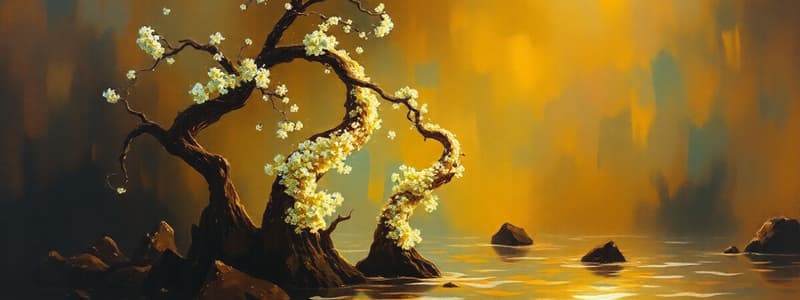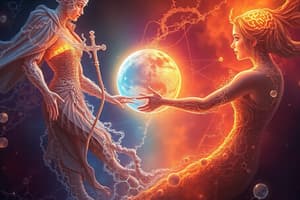Podcast
Questions and Answers
Which process describes a substance transitioning directly from a gaseous state to a solid state?
Which process describes a substance transitioning directly from a gaseous state to a solid state?
- Sublimation
- Deposition (correct)
- Freezing
- Condensation
At what point does a liquid transform into a vapor?
At what point does a liquid transform into a vapor?
- Triple point
- Boiling point (correct)
- Critical point
- Melting point
What is the defining characteristic of the 'critical point' in the context of phase changes?
What is the defining characteristic of the 'critical point' in the context of phase changes?
- The temperature at which a liquid transforms into a solid.
- The temperature and pressure beyond which liquid and vapor phases become indistinguishable. (correct)
- The point at which a solid transitions directly to a gas.
- The temperature and pressure where all three phases of matter coexist.
In a combination reaction, how many products are typically formed from multiple reactants?
In a combination reaction, how many products are typically formed from multiple reactants?
Which reaction type is characterized by a single reactant breaking down into two or more products?
Which reaction type is characterized by a single reactant breaking down into two or more products?
What are the typical reactants in a single-replacement reaction?
What are the typical reactants in a single-replacement reaction?
Double-replacement reactions primarily occur between what type of reactants?
Double-replacement reactions primarily occur between what type of reactants?
What are the constant products of a combustion reaction?
What are the constant products of a combustion reaction?
What distinguishes an endothermic reaction from an exothermic reaction?
What distinguishes an endothermic reaction from an exothermic reaction?
Which fundamental principle is always conserved during a chemical reaction?
Which fundamental principle is always conserved during a chemical reaction?
In an undisturbed sequence of sedimentary strata, which layer would generally contain the oldest fossils according to the principle of superposition?
In an undisturbed sequence of sedimentary strata, which layer would generally contain the oldest fossils according to the principle of superposition?
Which scientist is credited with organizing the elements based on increasing atomic number, leading to the structure of the modern periodic table?
Which scientist is credited with organizing the elements based on increasing atomic number, leading to the structure of the modern periodic table?
What distinguishes an element from a compound?
What distinguishes an element from a compound?
Which of the following is classified as a mixture rather than a pure substance?
Which of the following is classified as a mixture rather than a pure substance?
Which of the following describes a chemical property of matter?
Which of the following describes a chemical property of matter?
In an ionic bond, what is the primary mechanism of electron interaction between atoms?
In an ionic bond, what is the primary mechanism of electron interaction between atoms?
Which state of matter is characterized by having a definite volume but an indefinite shape?
Which state of matter is characterized by having a definite volume but an indefinite shape?
What type of bond is formed between two non-metal atoms when they share electrons unequally?
What type of bond is formed between two non-metal atoms when they share electrons unequally?
Which term describes the phase transition from a liquid to a gas?
Which term describes the phase transition from a liquid to a gas?
Metallic bonds are characterized by which of the following?
Metallic bonds are characterized by which of the following?
Which factor primarily contributes to the disproportionate representation of large animal species in the fossil record?
Which factor primarily contributes to the disproportionate representation of large animal species in the fossil record?
Why is rapid burial considered a crucial condition for fossil preservation?
Why is rapid burial considered a crucial condition for fossil preservation?
How do 'hard parts' of an organism primarily enhance the likelihood of fossilization?
How do 'hard parts' of an organism primarily enhance the likelihood of fossilization?
What role do 'the elements' play in the context of fossil preservation?
What role do 'the elements' play in the context of fossil preservation?
Which scenario represents the most favorable conditions for the fossilization of an organism?
Which scenario represents the most favorable conditions for the fossilization of an organism?
In contrast to ideal conditions, which scenario is least likely to result in fossil preservation?
In contrast to ideal conditions, which scenario is least likely to result in fossil preservation?
What is the defining characteristic of an index fossil that makes it useful for relative dating?
What is the defining characteristic of an index fossil that makes it useful for relative dating?
Which set of characteristics best describes ideal index fossils?
Which set of characteristics best describes ideal index fossils?
Ammonites, trilobites, and graptolites are specifically mentioned as examples of what type of fossil?
Ammonites, trilobites, and graptolites are specifically mentioned as examples of what type of fossil?
The principle of fossil succession, which utilizes index fossils, is most directly related to which method of geological dating?
The principle of fossil succession, which utilizes index fossils, is most directly related to which method of geological dating?
Flashcards
Fossils
Fossils
The remains or traces of once-living organisms preserved in rock.
Why large animals are more common in the fossil record
Why large animals are more common in the fossil record
Large animals often have larger bones that are more likely to survive the fossilization process.
Rapid burial in fossilization
Rapid burial in fossilization
The rapid burial of an organism increases its chances of becoming a fossil.
Hard parts in fossilization
Hard parts in fossilization
Signup and view all the flashcards
Index fossils
Index fossils
Signup and view all the flashcards
Time-limited existence of index fossils
Time-limited existence of index fossils
Signup and view all the flashcards
Characteristics of good index fossils
Characteristics of good index fossils
Signup and view all the flashcards
Relative dating
Relative dating
Signup and view all the flashcards
Principle of fossil succession
Principle of fossil succession
Signup and view all the flashcards
Fossil assemblage and relative age
Fossil assemblage and relative age
Signup and view all the flashcards
What is evaporation?
What is evaporation?
Signup and view all the flashcards
What's condensation?
What's condensation?
Signup and view all the flashcards
Define sublimation.
Define sublimation.
Signup and view all the flashcards
What is deposition?
What is deposition?
Signup and view all the flashcards
What is freezing?
What is freezing?
Signup and view all the flashcards
What is melting?
What is melting?
Signup and view all the flashcards
What is a combination reaction?
What is a combination reaction?
Signup and view all the flashcards
What is a decomposition reaction?
What is a decomposition reaction?
Signup and view all the flashcards
Describe a single-replacement reaction.
Describe a single-replacement reaction.
Signup and view all the flashcards
What happens in a double-replacement reaction?
What happens in a double-replacement reaction?
Signup and view all the flashcards
Principle of Superposition
Principle of Superposition
Signup and view all the flashcards
Periodic Table
Periodic Table
Signup and view all the flashcards
Law of Octaves
Law of Octaves
Signup and view all the flashcards
Atomic Number
Atomic Number
Signup and view all the flashcards
Element
Element
Signup and view all the flashcards
Molecule
Molecule
Signup and view all the flashcards
Covalent Bond
Covalent Bond
Signup and view all the flashcards
Ionic Bond
Ionic Bond
Signup and view all the flashcards
Gas
Gas
Signup and view all the flashcards
Phase Change
Phase Change
Signup and view all the flashcards
Study Notes
Fossil Preservation
- Large animals fossilize more readily due to larger, less-fragmented bones with more material for fossilization
- Rapid burial is crucial; scavengers quickly destroy smaller bones
- Weathering is a greater threat to smaller, less durable fossils
- Ideal conditions for fossil preservation include rapid, complete burial in a swamp or lake, followed by cold, dry conditions
- Conversely, small creatures with soft bodies, exposed to warm, moist conditions, and lacking rapid burial, are much less likely to fossilize, explaining why many of our best-known dinosaurs are large
Index Fossils
- Fossils are remains or traces of ancient organisms offering insights into sedimentary rocks
- Not all fossils can help date rocks or correlate them; some are ideal for this
- Index fossils are remains of organisms that lived for a brief, specific time window within Earth's history
- These fossils are common, widespread, and identifiable
- Examples include ammonites, trilobites, and graptolites
- Index fossils, along with the principle of superposition, help determine relative ages
- Principle of superposition states the oldest rock layer is at the bottom, younger layers above
- Older fossils tend to be found in lower rock layers, newer fossils in upper ones
- This helps correlate and date sedimentary rock strata
Periodic Table
- The periodic table organizes all known elements
- It is based on the number of protons in each element
- Johann Dobereiner's Law of Triads and John Newlands' Law of Octaves were early approaches but less accurate
- Dmitri Mendeleev is credited with creating a modern, organized periodic table
- Henry Moseley's arrangement based on atomic number was the key to accuracy in the modern table
- Periods (rows) and groups (columns) show recurring elements
- Elements are classified into metals, nonmetals, and metalloids
- Periodic trends correlate with elements' properties (valence electrons, atomic radius, ionization energy, electronegativity, electron affinity, oxidizing nature, and metallic character)
Elements and Atoms
- All matter is composed of elements, which are pure substances not further decomposable
- Each element is made of atoms, with distinct numbers of protons, neutrons, and electrons
- The atomic number is the number of protons, also the number of electrons
- The atomic number of an element distinguishes it from other elements
- Vast combinations of elements create all known matter in the universe
Molecules and Mixtures
- Elements combine to form molecules
- Molecules form from single atoms like H2 or multiple atoms like CH3Cl
- Ionic or covalent bonds hold atoms together in molecules
- Compounds are groups of molecules with their own properties
- Pure substances have only one type of compound
- Mixtures have two or more compounds/elements without chemical bonds
Matter
- Matter is anything that occupies space and has mass
- Matter has physical and chemical properties
- Physical properties don't change the substance's identity (color, mass, density)
- Chemical properties indicate a change in composition (pH, reactivity)
- Matter exists as pure substances (elements or compounds)
- Mixtures contain multiple pure substances
Chemical Bonding
-
Two main types of bonds are ionic and covalent bonds
-
Ionic bonds form from electron transfer between a metal and nonmetal
-
Covalent bonds form from shared electrons between nonmetals
-
Covalent bonds can be polar (unequal sharing) or nonpolar (equal sharing)
-
Other bond types include metallic bonds (sea of electrons) and hydrogen bonds (between hydrogen and other dipole atoms)
States of Matter
- Matter exists in four main states: solid, liquid, gas, and plasma
- States are defined by energy level, density, volume, and shape
- Matter can transition between phases (melting, freezing, condensation, evaporation, sublimation, deposition, ionization, deionization)
Phase Transitions
- Phase changes occur when energy/pressure are added or removed from a system
- Common phases include solid, liquid, and gas/vapor
- Evaporation (liquid to vapor/gas) occurs at the boiling point
- Condensation (gas/vapor to liquid) results from energy loss or pressure gain
- Sublimation (solid to gas) skips the liquid phase
- Deposition (gas to solid) skips the liquid phase
- Freezing (liquid to solid) happens with energy loss or pressure gain
- Melting (solid to liquid) happens with energy gain or pressure loss
- Supercritical fluids exist where the liquid/vapor boundary disappears
- The critical point is where vapor and liquid are indistinguishable
- The triple point is where all three phases can exist simultaneously
Chemical Reactions
- Five main types of chemical reactions are:
- Combination (multiple reactants to one product)
- Decomposition (one reactant to multiple products)
- Single replacement (one element replaces an element in a compound)
- Double replacement (elements from two ionic compounds switch places)
- Combustion (hydrocarbon and oxygen reactants form carbon dioxide and water)
- Chemical reactions involve rearrangement of atoms in reactants; matter is conserved
- Reactions can be endothermic (absorb energy) or exothermic (release energy)
Studying That Suits You
Use AI to generate personalized quizzes and flashcards to suit your learning preferences.




